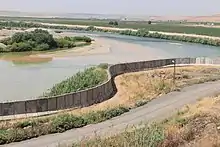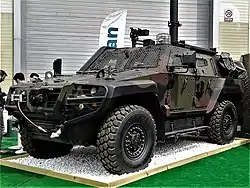Syria–Turkey barrier
The Syria–Turkey barrier is a border wall and fence under construction along the Syria–Turkey border built in an attempt at preventing illegal crossings and smuggling from Syria into Turkey.[1][2]

The barrier on the Syrian border is the third longest wall in the world after the Great Wall of China and the American-Mexico border wall.[3]
Background
According to Turkish officials the border wall was built in an attempt to increase border security, combat smuggling and reduce illegal border crossings due to the Syrian civil war.[4]
History
Ankara had launched the construction project in 2015 to increase border security.[4]
The 828 km (515-mile)[5][4] wall is being built by TOKI, Turkey's state-owned construction enterprise,[6] and will comprise Turkey's entire border with Syria. It will be made of seven-tonne concrete blocks topped with razor wire and stand three metres (9.8 feet) high and two metres (6.6 feet) wide;[7] it will include 120 border towers in critical locations and a security road[1] with regular military patrols.[7] With construction having begun in 2014,[8] 781 km of the border wall has been completed as of December 2017.[9] In June 2018, the wall was proclaimed to be finished with a length of 764-kilometer (475-mile) out of the 911 km Syrian-Turkish border.[4] In 2017, The Syrian government accused Turkey of building a separation wall, referring to this barrier.[10]
Specifics

The physical specifics are such as :
- base element: 2m wide, 7-tons mobile concrete blocks[4]
- height : 3m concrete + 1m razor wire[4]
- length : 764 km[4]
- sealed along : Hatay, Kilis, Gaziantep, Mardin, Şırnak, Şanlıurfa, as of June 2018,[4]
The border security includes :
- the modular concrete walls[4]
- security patrol routes[4] with regular military patrols[7]
- security towers, manned and unmanned[4]
- passenger tracks.[4]
Electronic devices are used, such as :
- close-up surveillance systems[4]
- thermal cameras[4]
- land surveillance radar[4]
- remote-controlled weapons systems[4]
- command-and-control centers[4]
- line-length imaging systems[4]
- seismic sensors[4]
- acoustic sensors.[4]
The advanced technology layer includes :
- wide area surveillance[4]
- laser destructive fiber-optic detection[4]
- surveillance radar for drone detection[4]
- jammers[4]
- short-distance movement-sensitive lighting systems.[4]
The barrier was expected to include 120 border towers in critical locations.[1]
The construction of Turkey's armored Cobra II military vehicles, which are now being used to patrol the border to Syria, has been funded by the European Union.[11]
Geography and size
781 km of the border wall has been completed as of December 2017, the whole 911 km is expected to be completed by Spring 2018.[9]
Separation barrier and incursion into Syria controversy
In 2017, the Syrian government accused Turkey of building a separation wall, referring to the barrier.[10] Syrian Foreign Ministry officials claimed Turkish forces and border control guards brought in heavy machines and trucks into Syrian territories, particularly in the northern countryside of Hasakah province, making a dirt road and digging a trench while installing cement pillars to build a separation wall. Turkish forces were also claimed to enter the Syrian territory at a depth of 250 meters in the northern countryside of Aleppo province. The Turkish forces also repeated the move in the northwestern province of Idlib, saying that the Turkish forces captured six acres of lands with the same aim to build the wall. Syrian regime officials have stated that any unilateral international actions without the consent of the Syrian government will be dealt with as violations to Syria's sovereignty.[10]
References
- Reuters: "Turkish developer confident Syria wall in place by spring" By Nevzat Devranoglu and Orhan Coskun December 9, 2016
- The Daily Telegraph: "Turkey to build 500-mile wall on Syria border after Isil Suruc bombing" by Nabih Bulos 23 Jul 2015
- "Turkey-Syria border wall to be completed by spring - Turkey News". Hürriyet Daily News.
- "Turkey finishes construction of 764-km security wall on Syria border". ANADOLU AGENCY. 2018-06-09.
- Daily Sabah: "Turkey-Syria border wall construction nears completion" 11 Jun 2017
- "Turkey's 'great wall' nearing completion". Al Monitor. 2017-07-14. Retrieved 14 July 2017.
- Business Insider: "Turkey is getting close to finishing its border wall with Syria" by Orhan Coskun and Daren Butler September 28, 2016
- Afanasieva, Dasha (5 May 2014). "Turkey builds wall in token effort to secure border with Syria". Reuters.
- Hurriyet Daily News: "Turkey-Syria border wall to be completed by spring" 18 Dec 2017
- "Damascus accuses Turkey of building separation wall in northern Syria - Xinhua | English.news.cn". www.xinhuanet.com.
- SPIEGEL, Maximilian Popp, DER (29 March 2018). "Firing at Refugees: EU Money Helped Fortify Turkey's Border". Der Spiegel.
{{cite news}}: CS1 maint: multiple names: authors list (link)
External links
- Images of the barrier published by the Turkish Ministry of Defense on Twitter
- "New wall closes Turkey-Syria border". Deutsche Welt. May 3, 2017.